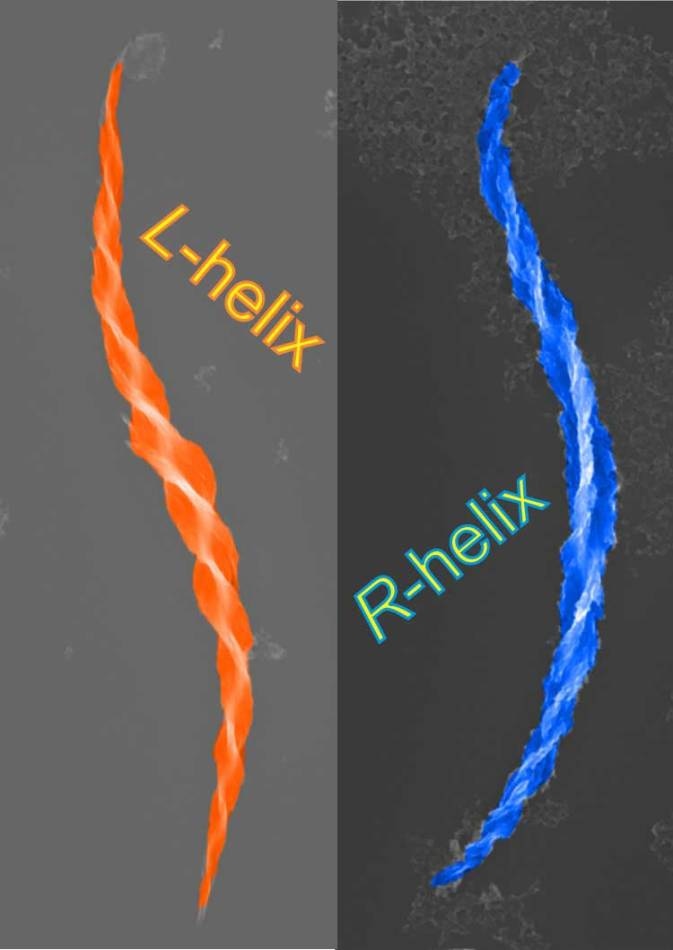Mar 30 2017
 Colorized electron microscope images of a right-handed helix and a left-handed helix. Image credit: Wenchun Feng, Kotov Lab
Colorized electron microscope images of a right-handed helix and a left-handed helix. Image credit: Wenchun Feng, Kotov Lab
A smartphone display producing moving, holographic 3D images must also be able to twist the light it emits.
Recently, a method to mass-produce spiral semiconductors capable of taking that crucial light-coiling step was discovered by researchers at the University of Michigan and Ben-Gurion University of the Negev.
Some of the first holographic images were unveiled by U-M researchers in 1962, by coaxing waves of light to form a range of dark and bright spots in space, producing a static illusion of a material object. Researchers produced these frozen waves by encoding images onto a material capable of controlling the timing (phase) and direction (polarization) of the fluctuations within the electromagnetic waves.
The new semiconductor helices discovered by the U-M-led team provide the particular level of control over light in a specific format that could work in the pixels of displays. In order to vary the polarization, phase, and color of light emitted by the different pixels, the semiconductor helices can be incorporated into other semiconductor devices. It is possible to make each semiconductor from precisely-designed semiconductor helices. In the future, this could enable moving holograms, which are projected by smartphones and various other screens.
Until recently, creating semiconductors spirals with an adequately strong twist — similar to nanoscale fusilli pasta — was difficult since the twisted state is not natural to semiconductor materials, as they usually form only wires or sheets. However, Nicholas Kotov, the Joseph B. and Florence V. Cejka Professor of Chemical Engineering, and his team have found that by using proteins and DNA, nature’s twisted structures, the small semiconductor nanoparticles can be attached to each other.
Amino acids are the quintessential building blocks of proteins. The direction of the spiral of proteins is determined by the geometrical property of amino acids. We found that a common amino acid, cysteine, working together in large numbers, can twist not only proteins but also semiconductors.
Wenchun Feng, Postdoctoral Research Fellow, University of Michigan
Nanoparticles produced from cadmium telluride, a semiconductor that can emit light, were coated with cysteine. Cysteine is available in two forms, which are mirror images of one another, similar to human hands. Thus, it is known as a "chiral" molecule. The team noted that the nanoparticles spontaneously self-assembled into semiconductor "tornadoes" following the leftward or rightward chirality of the amino acid.
The strength of the twist and the high fidelity of this self-assembly process surprised the team. The same twisting direction was found in almost all — 98% — of semiconductor helices; the helices were also similar to nanoscale fusilli in appearance. The light-twisting ability of semiconductor helices created by Kotov and colleagues is at least five times stronger than that of the natural spirals formed by some organic molecules.
When light was shone through the semiconductors, the team recorded the photons swirling through them. The researchers developed design principles and methods for formulating the optical properties of the semiconductor helices for a wide range of colors in future holography devices. This was achieved by a combination of computer simulations and experimentation.
This technology-driven project also unexpectedly provided a quick look into the mysteries surrounding the origin of life on Earth and the reason behind many biological molecules having a clockwise or anti-clockwise spiral. According to Kotov, amino acids, spontaneously forming in space dust, may have assembled nanoparticles into spirals causing a twist in the light from the early stars. This arrangement could have served as stable inorganic templates for organic particles and molecules to follow the same pattern.
The work is discussed in a study in Science Advances titled, "Assembly of mesoscale helices with near-unity enantiomeric excess and light-matter interactions for chiral semiconductors."
The NSF project "Energy- and Cost-Efficient Manufacturing Employing Nanoparticles" (NSF 1463474) supported the main part of this work. Partial support was provided by the Center for Photonic and Multiscale Nanomaterials, funded by the NSF Materials Research Science and Engineering Center program (DMR-1120923), and the NSF projects 1411014 and 1403777. The analytical electron microscope (provided by NSF grant DMR-9871177) employed for this work is part of the U-M’s Michigan Center for Materials Characterization.